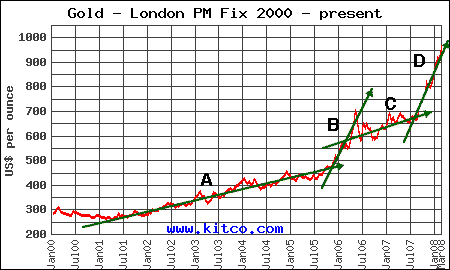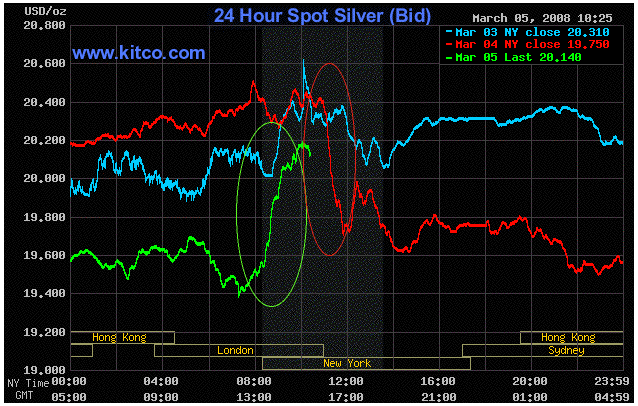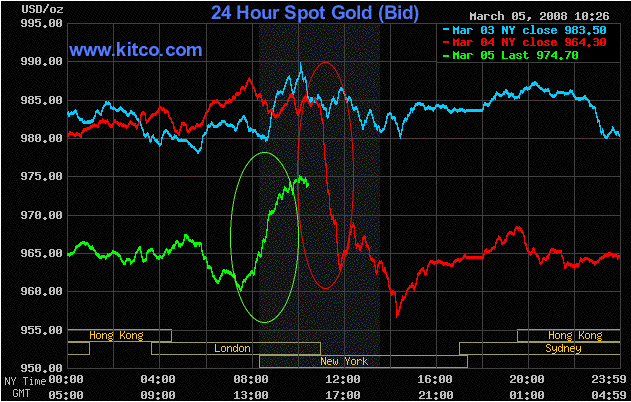 |
We remain long gold as we have since August 2001. Recent price action compels us to remind readers that the precious metals markets have two primary drivers, with the currency depreciation and inflation trade driving long term prices and highly leveraged trades by funds driving short term price action.
Note the following long term price dynamic.

Since 2001, the gold price has increased in four distinct growth trends as depicted above.
A. 2001 - 2006: Post-bubble gradual currency depreciation and inflation trade
B. H1 2006: Rapid speculative trade
C. H2 2006 - 2007: Resumption of gradual currency depreciation and inflation trade
D. 2007 - Present: New rapid speculative trade
Within the current rapid speculative trade, we are watching for short term price volatility much as occurred at the end of the previous similar period C (H1 2006): a 20% correction from $720 to $580. A similar correction today would take gold prices down $200. We are also within the long term for volatility that will portend the end of the currency depreciation and inflation trade that began in 2001.
The reason for yesterday's News with AntiSpin is the following observation of coordinated gold and silver price action March 4th and 5th.
Note in the two charts below that show gold and silver spot prices March 3 thru March 5. Both declined at the same time march 4 just before noon Eastern time and partially recovered in a similarly steep price change after 8AM Eastern time March 5.


In view of the charts above we ask: what trade forces are driving these simultaneous short term price changes in two precious metals markets, for silver and for gold? Platinum (not shown) remained unchanged.
We are certain that it is not the same long term function that drove prices gradually in periods A and C defined above. We believe these short term price movements are driven by funds.
A Tale of Two Markets
Within the long gold and silver trade are players that create price movements that at times are counter to the long term trend and at other times exaggerate the long term trend. It is our position that the pullbacks created by the short term counter trends are buying opportunities for long investors and for traders the peaks of exaggerated short term price movements are selling opportunities. More importantly it is critical to distinguish between the kind of price volatility that funds can create with leverage versus the kind of price volatility we will see at the end of the long term PM inflation trade in place since 2001.
We do not foresee in light of ongoing liquidity problems in global bond markets, combined with slowing economic growth and rising inflation around the world, how governments will be able to make bonds more attractive than hard assets by raising yields above the rate of inflation to draw money away as occurred in the early 1980s during the previous cycle at a time when increased liquidity is needed to manage the debt deflation.
As long as future real interest rate expectations remain negative, the long PMs position that we took in 2001 remains in place.
We are certain that it is not the same long term function that drove prices gradually in periods A and C defined above. We believe these short term price movements are driven by funds.
A Tale of Two Markets
Within the long gold and silver trade are players that create price movements that at times are counter to the long term trend and at other times exaggerate the long term trend. It is our position that the pullbacks created by the short term counter trends are buying opportunities for long investors and for traders the peaks of exaggerated short term price movements are selling opportunities. More importantly it is critical to distinguish between the kind of price volatility that funds can create with leverage versus the kind of price volatility we will see at the end of the long term PM inflation trade in place since 2001.
We do not foresee in light of ongoing liquidity problems in global bond markets, combined with slowing economic growth and rising inflation around the world, how governments will be able to make bonds more attractive than hard assets by raising yields above the rate of inflation to draw money away as occurred in the early 1980s during the previous cycle at a time when increased liquidity is needed to manage the debt deflation.
As long as future real interest rate expectations remain negative, the long PMs position that we took in 2001 remains in place.
iTulip Select: The Investment Thesis for the Next Cycle™
__________________________________________________
To receive the iTulip Newsletter and iTulip Alerts, Join our FREE Email Mailing List
Copyright © iTulip, Inc. 1998 - 2007 All Rights Reserved
All information provided "as is" for informational purposes only, not intended for trading purposes or advice. Nothing appearing on this website should be considered a recommendation to buy or to sell any security or related financial instrument. iTulip, Inc. is not liable for any informational errors, incompleteness, or delays, or for any actions taken in reliance on information contained herein. Full Disclaimer
Comment